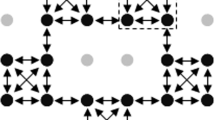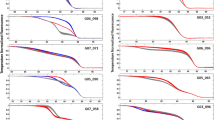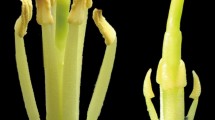Abstract
Gametophytic self-incompatibility (GSI) in the grasses is controlled by a distinct two-locus genetic system governed by the multiallelic loci S and Z. We have employed diploid Hordeum bulbosum as a model species for identifying the self-incompatibility (SI) genes and for elucidating the molecular mechanisms of the two-locus SI system in the grasses. In this study, we attempted to identify S haplotype-specific cDNAs expressed in pistils and anthers at the flowering stage in H. bulbosum, using the AFLP-based mRNA fingerprinting (AMF, also called cDNA-AFLP) technique. We used the AMF-derived DNA clones as markers for fine mapping of the S locus, and found that the locus resided in a chromosomal region displaying remarkable suppression of recombination, encompassing a large physical region. Furthermore, we identified three AMF-derived markers displaying complete linkage to the S locus, although they showed no significant homology with genes of known functions. Two of these markers showed expression patterns that were specific to the reproductive organs (pistil or anther), suggesting that they could be potential candidates for the S gene.








Similar content being viewed by others
References
Baumann U, Juttner J, Bian XY, Langridge P (2000) Self-incompatibility in the grasses. Ann Bot 85(Suppl A):203–209
Bian XY, Friedrich A, Bai J-R, Baumann U, Hayman DL, Barker SJ, Langridge P (2004) High-resolution mapping of the S and Z loci of Phalaris coerulescens. Genome 47:918–930
Casselman AL, Vrebalov J, Conner JA, Singhal A, Giovannoni J, Nasrallah ME, Nasrallah JB (2000) Determining the physical limits of Brassica S locus by recombinational analysis. Plant Cell 12:23–33
De Vries S, Hoge H, Bisseling T (1988) Isolation of total and polysomal RNA from plant tissue. In: Gelvin SB, Schilperoort RA (eds) Plant molecular biology manual. Kluwer, Dordrecht, pp B61–B613
Furusho M, Yoshino M, Yoshida T (1992) Selection for spring-habitat clones of Hordeum bulbosum. Crop Sci 32:384–385
Gudu S, Laurie A, Kasha J, Xia J, Snape W (2002) RFLP mapping of a Hordeum bulbosum gene highly expressed in pistils and its relationship to homoeologous loci in other Gramineae species. Theor Appl Genet 105:271–276
Hackauf B, Wehling P (2005) Approaching the self-incompatibility locus Z in rye (Secale cereale L) via comparative genetics. Theor Appl Genet 110:832–845
Hayman DL (1956) The genetic control of incompatibility in Phalaris coerulescens DESF. Austrl J Biol Sci 9:321–331
Jaffé B, Caligari PDS, Snape JW (2000) A skeletal linkage map of Hordeum bulbosum L. and comparative mapping with barley (H. vulgare L.). Euphytica 115:115–120
Kakeda K, Ibuki T, Kowyama Y (2000) Molecular genetic analysis of self-incompatibility in Hordeum bulbosum. In: Logue S (ed) Barley genetics VIII, vol 3, Proc 8th Int Barley Genet Sym Univ Adelaide, Australia, pp 157–159
Kakeda K, Hanai Y, Sato K (2004) Differential expression proteomics in barley and its wild relatives. In: Spunar J, Janikova J (eds) Proc 9th Int Barley Genet Sym. Agr Res Inst Kromeriz Ltd, Czech Republic, pp 354–359
Komatsuda T, Tanno K-I, Salomon B, Brymgelsson T, von Bothmer R (1999) Phylogeny in the genus Hordeum based on nucleotide sequences closely linked to the vrs1 locus (row number of spikelets). Genome 42:973–981
Kosambi DD (1944) The estimation of map distances from recombination values. Ann Eugen 12:172–175
Kowyama Y, Tsuchiya T, Kakeda K (2008) Molecular genetics of sporophytic self-incompatibility in Ipomoea, a member of the Convolvulaceae. In: Franklin-Tong VE (ed) Self-incompatibility in flowering plants—evolution, diversity, and mechanisms. Springer, Berlin, pp 259–274
Künzel G, Korzun L, Meister A (2000) Cytologically integrated physical restriction fragment length polymorphism maps for the barley genome based on translocation breakpoints. Genetics 154:397–412
Langridge P, Baumann U, Juttner J (1999) Revisiting and revising the self-incompatibility genetics of Phalaris coerulescens. Plant Cell 11:18–26
Leach CR (1988) Detection and estimation of linkage for a codominant structural gene locus linked to a gametophytic self-incompatibility locus. Theor Appl Genet 75:882–888
Li X, Nield J, Hayman D, Langridge P (1994) Cloning a putative self-incompatibility gene from the pollen of the grass Phalaris coerulescens. Plant Cell 6:1923–1932
Li X, Paech N, Nield J, Hayman D, Langridge P (1997) Self-incompatibility in the grasses: evolutionary relationship of the S gene from Phalaris coerulescens to homologous sequences in other grasses. Plant Mol Biol 34:223–232
Lundqvist A (1954) Studies on self-sterility in rye, Secale cereale L. Hereditas 40:278–294
Lundqvist A (1962) Self-incompatibility in diploid Hordeum bulbosum L. Hereditas 48:138–152
McCubbin AG, Wang X, Kao TH (2000) Identification of self-incompatibility (S-) locus linked pollen cDNA markers in Petunia inflata. Genome 43:619–627
McClure BA, Franklin-Tong V (2006) Gametophytic self-incompatibility: understanding the cellular mechanisms involved in “self” pollen tube inhibition. Planta 224:233–245
de Nettancourt D (2001) Incompatibility and incongruity in wild and cultivated plants. Springer, Berlin
Rahman MH, Tsuchiya T, Suwabe K, Kohori J, Tomita RN, Kagaya Y, Kobayashi I, Kakeda K, Kowyama Y (2007a) Physical size of the S locus region defined by genetic recombination and genome sequencing in Ipomoea trifida, Convolvulaceae. Sex Plant Reprod 20:63–72
Rahman MH, Uchiyama M, Kuno M, Hirashima N, Suwabe K, Tsuchiya T, Kagaya Y, Kobayashi I, Kakeda K, Kowyama Y (2007b) Expression of stigma- and anther-specific genes located in the S locus region of Ipomoea trifida. Sex Plant Reprod 20:73–85
Rogers RS, Bendich AJ (1988) Extraction of DNA from plant tissues. In: Gelvin SB, Schilperoort RA (eds) Plant molecular biology manual. Kluwer, Dordrecht, pp A61–A610
Salvo-Garrido H, Laurie DA, Jaffé B, Snape JW (2001) An RFLP map of diploid Hordeum bulbosum L. and comparison with maps of barley (H. vulgare L.) and wheat (Triticum aestivum L.). Theor Appl Genet 103:869–880
Sourdille P, Singh S, Cadalen T, Brown-Guedira GL, Gay G, Qi L, Gill BS, Dufour P, Murigneux A, Bernard M (2004) Microsatellite-based deletion bin system for the establishment of genetic-physical map relationships in wheat (Triticum aestivum L.). Funct Integr Genomics 4:12–25
Svitashev S, Bryngelsson T, Vershinin A, Pedersen C, Sall T, von Bothmer R (1994) Phylogenetic analysis of the genus Hordeum using repetitive DNA sequences. Theor Appl Genet 89:801–810
Takayama S, Isogai A (2005) Self-incompatibility in plants. Annu Rev Plant Biol 56:467–489
Takayama S, Shiba H, Iwano M, Shimosato H, Che FS, Kai N, Watanabe M, Suzuki G, Hinata K, Isogai A (2000) The pollen determinant of self-incompatibility in Brassica campestris. Proc Natl Acad Sci USA 97:1920–1925
Taketa S, Choda M, Ohashi R, Ichii M, Takeda K (2002) Molecular and physical mapping of a barley gene on chromosome arm 1 HL that causes sterility in hybrids with wheat. Genome 45:617–625
Thorogood D, Kaiser WJ, Jones JG, Armstead I (2002) Self-incompatibility in ryegrass 12. Genotyping and mapping the S and Z loci of Lollium perenne L. Heredity 88:385–390
Tomita RN, Fukami K, Takayama S, Kowyama Y (2004a) Genetic mapping of AFLP/AMF-derived DNA markers in the vicinity of the self-incompatibility locus in Ipomoea trifida. Sex Plant Reprod 16:265–272
Tomita RN, Suzuki G, Yoshida K, Yano Y, Tsuchiya T, Kakeda K, Mukai Y, Kowyama Y (2004b) Molecular characterization of a 313-kb genomic region containing the self-incompatibility locus of Ipomoea trifida, a diploid relative of sweet potato. Breed Sci 54:165–175
Van Daele I, Van Bockstaele E, Martens C, Roldán-Ruiz I (2008) Identification of transcribed derived fragments involved in self-incompatibility in perennial ryegrass (Lolium perenne L.) using cDNA-AFLP. Euphytica 163:67–80
Voylokov AV, Korzun V, Borner A (1997) Mapping of three self-fertility mutations in rye (Secale cereale L.) using RFLP, isozyme and morphological markers. Theor Appl Genet 97:147–153
Wang Y, Wang X, McCubbin AG, Kao T-H (2003) Genetic mapping and molecular characterization of the self-incompatibility (S) locus in Petunia inflata. Plant Mol Biol 53:565–580
Wang Y, Tsukamoto T, Yi K-W, Wang X, Huang S, McCubbin AG, Kao T-H (2004) Chromosome walking in the Petunia inflata self-incompatibility (S-) locus and gene identification in an 881-kb contig containing S 2 -RNase. Plant Mol Biol 54:727–742
Wehling P, Hackauf B, Wricke B (1994) Identification of S-locus linked PCR fragments in rye (Secale cereale L.) by denaturing gradient gel electrophoresis. Plant J 5:891–893
Yang B, Thorogood D, Armstead I, Barth S (2008) How far are we from unraveling self-incompatibility in grasses? New Phytol 179:740–753
Acknowledgments
We thank Drs T. Makino and M. Furusho for providing the H. bulbosum plants (SH7 and SH10) used as parental strains for generating segregating populations. This work was supported by Grant-in Aids for Scientific Research C (Nos. 12660005 and 15580006) from the Ministry of Education, Culture, Sports, Science and Technology, Japan (MEXT) to K.K.
Author information
Authors and Affiliations
Corresponding author
Additional information
Communicated by S. Hohmann.
Nucleotide sequence data reported are available in the DDBJ/EMBL/GenBank databases under the accession numbers AB455978–AB455990.
Electronic supplementary material
Below is the link to the electronic supplementary material.
438_2008_383_MOESM1_ESM.TIF.tif
S mapping population 1 (SMP1). a S and Z genotypes of theparents and their gametes. The S genotype of all progeny must be S1S2 because onlyS2Z2 pollen can effect fertilization on the pistil with the genotype S1.1 Z2.3. The Zgenotypes are expected to segregate as Z2.2 and Z2.3 in a ratio of 1:1. b Detection ofrecombinants between S and an adjacent marker locus, designated as M (for example,HTL in this study). Assuming that two marker alleles M1 and M2 are located adjacent tothe S1 and S2 alleles, respectively, in the pollen parent, only the S2M1 and S2M2 pollencan effect fertilization because S1 pollen is incompatible. The S2M1 gamete resultsfrom a recombination between the S and M loci. Thus, one can distinguish betweenrecombinants (M1M1) and non-recombinants (M1M2) by checking the marker genotypes only. We also generated the ZMP1 population by the reciprocal cross(S1.2Z2.2 x S1.1Z2.3) to detect recombinants between Z and an adjacent marker locus(bcd266). In this case, the marker genotype M2M2 represented the recombinant whileM2M3 were non-recombinants. (TIFF 169 kb)
Rights and permissions
About this article
Cite this article
Kakeda, K., Ibuki, T., Suzuki, J. et al. Molecular and genetic characterization of the S locus in Hordeum bulbosum L., a wild self-incompatible species related to cultivated barley. Mol Genet Genomics 280, 509–519 (2008). https://doi.org/10.1007/s00438-008-0383-9
Received:
Accepted:
Published:
Issue Date:
DOI: https://doi.org/10.1007/s00438-008-0383-9




